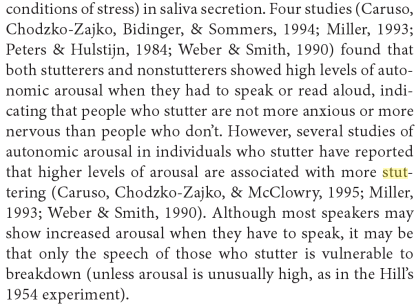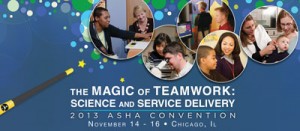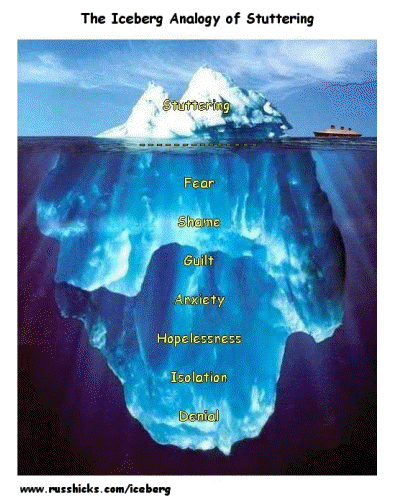ASHA 2013 finished today. This was my first time attending an ASHA convention, and I am right tuckered out. I just finished logging my continuing education hours. Sixteen hours of panels, discussion, research, therapy techniques, and questions over three days.
Eleven of my sixteen hours were dedicated to fluency. There is very exciting research happening in the science of stuttering. Smith and Weber-Fox's neurodevelopmental, epigenetic model was the talk of the conference (at least for us fluency folks). This morning's panel on sensorimotor advances was an invaluable smorgasbord of data providing insight to the stuttering brain.
In addition to technical neuroimaging research sessions, I attended several sessions focused on the psychoemotional aspects of stuttering. I learned that acceptance and commitment therapy (ACT) has tremendous potential for PWS. Words cannot describe what was shared during the stuttering and suicide panel, but the tears from both the audience and speakers say volumes. Perceptions, thoughts, beliefs, awareness, mindfulness are the words ringing in my ears after three days of immersion in the stuttering psyche.
The Stuttering Iceberg
Virtually every fluency professional and PWS who's attended speech therapy knows about the stuttering iceberg (why someone has not created a higher-res image for us to reference, I know not). For adults and self-aware children who stutter (AWS and CWS), the physical manifestation of disordered speech is only the "tip" of the communication disorder. Most of the negative impact lies beneath the surface, and these thoughts, feelings, and perceptions about the entire self, not just speech.
Stuttering treatment approaches and philosophies vary wildly by clinician. I attended one session where the speakers emphasized fluency shaping and "controlled speech", and others where the approach was avoidance reduction and "let the block out". To say I loved Janet Beilby's research of group-based ACT (mindfulness) paired with traditional technique-based therapy is an understatement. I follow a very similar model (individual, though I am wholeheartedly searching for a feasible group version) in my own therapy, and her outcomes showed positive statistical changes and stories of personal triumph-- the best of both worlds.
Art and Science
When setting up my personal session schedule in Google Calendar, I color-coded all interesting timeslot options according to subject area (stuttering, voice, telepractice, etc.). With stuttering, though, I felt like I needed two different colors. One for "stuttering science": neuroimaging, inverse models, ANOVAs, grey matter volume, epigenetics. Another for "stuttering art": counseling, meditation, awareness, depression, hope, the life of thoughts and emotions.
The "hard" scientists have groundbreaking, outstanding insights about the stuttering brain. The "soft" scientists have practical, exciting methods for accessing the stuttering mind and heart...
"...and ne'er the twain shall meet"
For me personally, stuttering is a profound life experience. Its impact can be devastating, empowering, and everything in between. I started my own practice so that I could have the flexibility and freedom to explore the real-life challenges of communication disorders. This is a "soft" concept, but there is a "hard" scientific term for what inspired me to start something new: performance variability. The more time I spent with AWS, the more determined I became to figure out a way to work on self and communication in context.
I love neuroimaging data, and so I eagerly awaited ASHA hoping that some of the excellent neuro and sensorimotor research would provide insight as to what is going on in Adam's brain when he's talking to me vs. making a client call. Part of acceptance is riding those waves of performance variability. But it sure would be nice to know where they come from. Especially because those challenging, variability-inducing situations are often predictable!
But, as I huffed and puffed my way from one end of McCormick Place t'other, I found no answer. One poster session found "an association between emotional processes and childhood stuttering", based on sympathetic arousal. Sensory gating, inverse models, auditory feedback. Perceptions, attitudes, grief, acceptance. These sets of words never co-occur.
Cortisol?

Stuttering: An Integrated Approach to Its Nature and Treatment By Barry Guitar
By no means am I an expert or even consider myself familiar with the intricacies and history of stuttering research, hard and soft. With Amy Cuddy's TED Talk in the back of my mind, I came home on Saturday and googled "stuttering cortisol". I found links to Blood (1997 and 1994) and references to studies on autonomic arousal during speaking tasks. Nothing on brain, stress, and speech production. [Or at least, nothing that this average clinician can readily access.]
The "whole-person" approach
For all the emphasis on holistic, "whole person" approaches to therapy, especially in stuttering treatment, our research is surprisingly lacking. Torrey Louck discussed the exciting possibilities of simultaneous scanning to visually match brain activity to motor acts. Why can we not incorporate emotions into our hard science questions? Or validate our self-awareness strategies with neuroimaging?
"We have the technology" to answer questions like:
- How do cortisol levels relate to cortical activation for speech tasks in AWS vs. AWNS?
- Do cortisol levels in varying [situational] speech tasks correlate to various psychometric profiles among AWS?
- And, ultimately, what kind of treatment approach yields the most comprehensive outcome?
Do motor-based approaches that repair or compensate for neurosensorimotor function yield positive fluency and psychometric change? Does the anecdotal observation that reducing fear, avoidance, and stress often facilitates more fluent motor execution have a biological basis? My personal bias certainly falls in the letting go and acceptance camp, but I fully agree with Dr. Beilby's statement of, "We're not naive. People come to us because they want to be more fluent." Whatever approach we take, we need to respect the goals and values of our individual clients. And we have the tools to achieve this in a controlled, measurable way!
Magic!
If I learned one thing from my first-ever ASHA, it is that we have incredibly talented minds and hearts asking complicated questions about what makes communication work and how can we make it work better. We are researchers, scientists, clinicians, artists.
Our theme this year was "the magic of teamwork". Let's make some magic happen.



